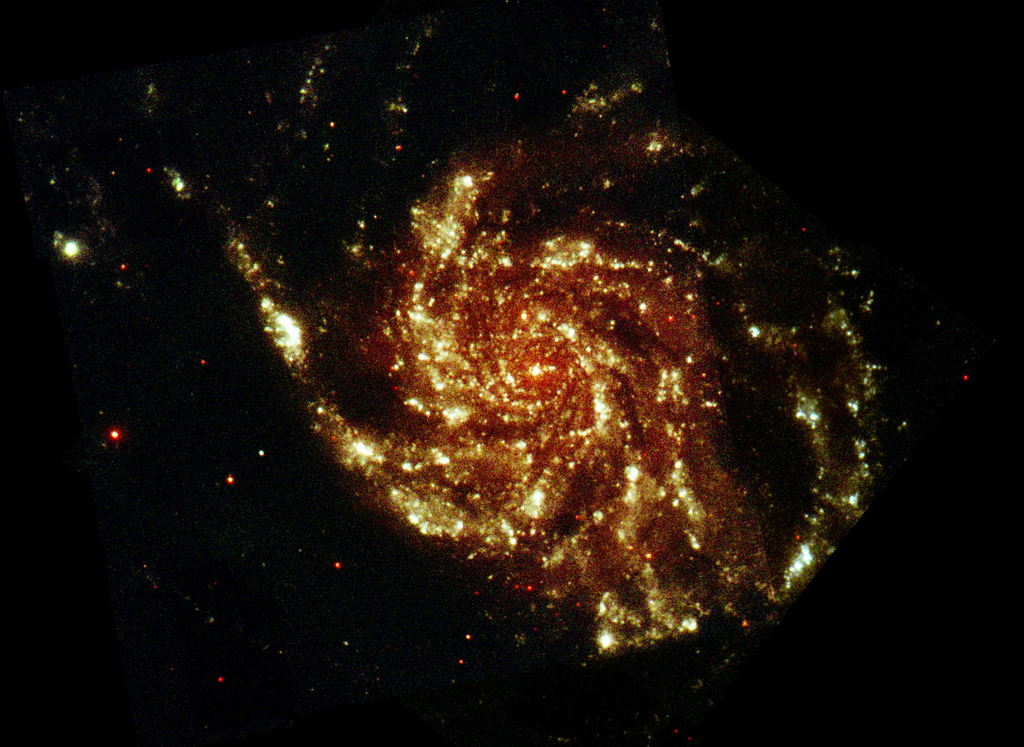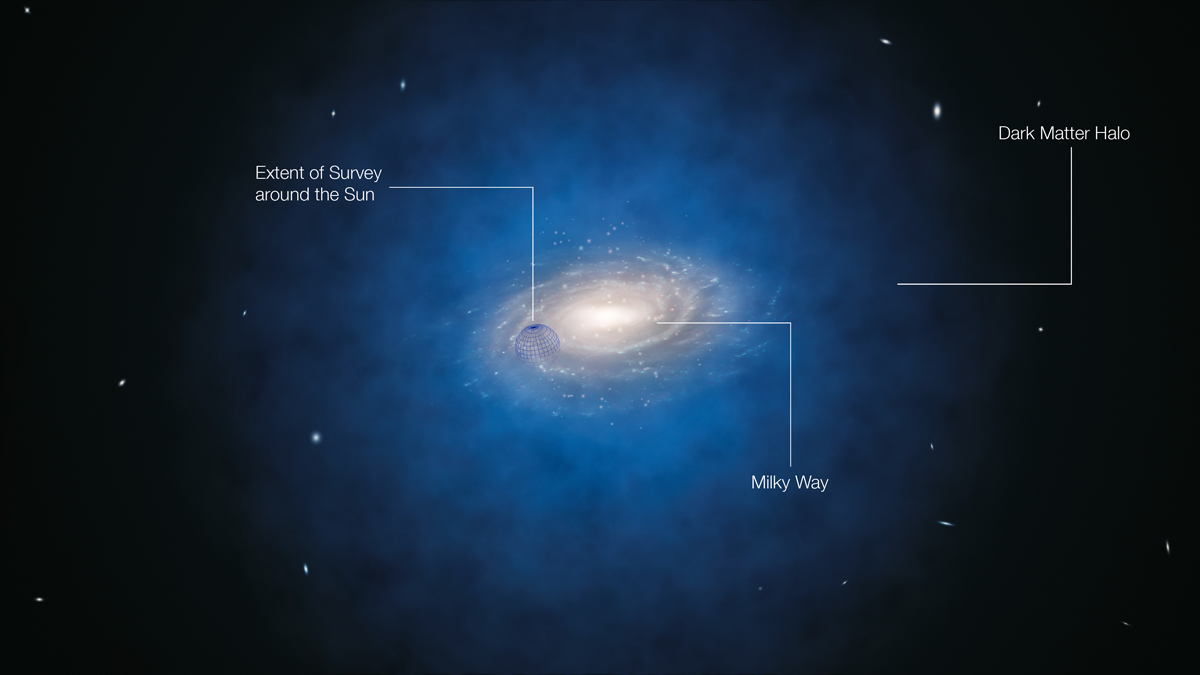Dark Matter Could Create Halos of Light Around Galaxies

Dark matter might not be totally dark: A new study reports that if dark matter has even a small interaction with particles of light, it could create a visible glow around galaxies.
Searching for light from the darkest substance in the universe may seem like an oxymoron, but scientists can't rule out the possibility that dark matter and light occasionally interact.
If particles of light can scatter off of dark matter, a new study suggests that this interaction could create "halos of light" around galaxies. The authors of the new work say there are telescopes in operation that could look for this dark matter glow. [Gallery: Dark Matter Throughout the Universe]
Looking for a dark matter glow
Roughly 80 percent of the matter in the universe is dark matter. While scientists cannot see dark matter, they know it exists in significant amounts because it exerts a gravitational pull on regular matter. Without dark matter, many galaxies would fly apart, unable to hold all the stars together while spinning at such high speeds.

Scientists have never directly observed dark matter — light appears to pass through it as if it weren't there at all. But it's possible that interactions between dark matter and light occur, but haven't been observed yet.
"The basic idea [of our work] is quite simple: can you say that dark matter is perfectly dark?" Jonathan Davis, a postdoctoral researcher at the Paris Institute of Astrophysics, said. "We want to put a number on how dark it is."
Davis is the lead author on a new paper that suggests that if starlight in galaxies occasionally scatters off dark matter, it would create a halo of light around the galaxy. This effect is the same for light scattering off of regular matter. Fog, for example, can turn a narrow beam of light into a diffuse glow.
Get the Space.com Newsletter
Breaking space news, the latest updates on rocket launches, skywatching events and more!
"We know dark matter exists around galaxies and we want to ask — if light from the galaxy can scatter off the dark matter, like a dust cloud, can you actually observe this light?" Davis said.
Davis and his co-author, Joseph Silk, an astrophysicist at Johns Hopkins University, went looking for this kind of glow around the galaxy Messier 101, also known as the Pinwheel Galaxy, using data from the Dragonfly Telephoto Array.
"These telescopes were designed to look for diffuse light around galaxies. Not in the context of dark matter, but you can repurpose the data to look for this glow," Davis said. "[The Dragonfly telescopes] are really good at looking for this high contrast between the really bright galactic center and the really dim outskirts of galaxies."
The hunt came up empty — there was no halo in this particular wavelength. But Davis said he hopes the results inspire someone to make a more dedicated search for one of these halos. [8 Baffling Astronomy Mysteries]
A dark particle
Scientists don't know what kind of particle (or particles) make up dark matter, so they don't know for sure what kind of interactions it would have with other particles. These interactions could be somewhat rare.
Particles called neutrinos, for example, shower down on the Earth every second of every day, but for the most part they pass through matter like ghosts. But every once in a while, a neutrino will collide with an atom of regular matter. It's possible that dark matter particles have a similarly low, but not nonexistent, interaction rate with light.
Davis said that if dark matter interacts with light it would have to be made of a charged particle. One of the leading dark matter theories favors weakly interacting massive particles, or WIMPS, which are neutral. But Davis said there are other theories about dark matter that include charged particles.
Davis and Silk are not the only scientists looking for dark matter interactions with light. Carolyn Boehm at the University of Durham (who served as Davis' Ph.D. adviser) has spent years studying how dark matter interactions with light could influence the formation of galaxies and galaxy clusters.
If dark matter interacts with photons and other particles, those interactions could scatter the dark matter. This, in turn, could wipe out structures that trap gas and eventually form galaxies, according to a news release from the Royal Astronomical Society. In September, Boehm co-authored a paper suggesting that dark matter and photon interactions might explain why there are not as many galaxies orbiting the Milky Way, as some scientists expect.
Boehm said in an email to Space.com that she feels the merit of the new work by Davis and Silk lies in the idea of using halos to constrain dark matter interactions with light.
Looking forward, Davis said he hopes the publication of the new work draws attention from other scientists who might like to join the search for light from the darkest substance in the universe.
Follow Calla Cofield @callacofield.Follow us @Spacedotcom, Facebook and Google+. Original article on Space.com.
Join our Space Forums to keep talking space on the latest missions, night sky and more! And if you have a news tip, correction or comment, let us know at: community@space.com.

Calla Cofield joined Space.com's crew in October 2014. She enjoys writing about black holes, exploding stars, ripples in space-time, science in comic books, and all the mysteries of the cosmos. Prior to joining Space.com Calla worked as a freelance writer, with her work appearing in APS News, Symmetry magazine, Scientific American, Nature News, Physics World, and others. From 2010 to 2014 she was a producer for The Physics Central Podcast. Previously, Calla worked at the American Museum of Natural History in New York City (hands down the best office building ever) and SLAC National Accelerator Laboratory in California. Calla studied physics at the University of Massachusetts, Amherst and is originally from Sandy, Utah. In 2018, Calla left Space.com to join NASA's Jet Propulsion Laboratory media team where she oversees astronomy, physics, exoplanets and the Cold Atom Lab mission. She has been underground at three of the largest particle accelerators in the world and would really like to know what the heck dark matter is. Contact Calla via: E-Mail – Twitter









